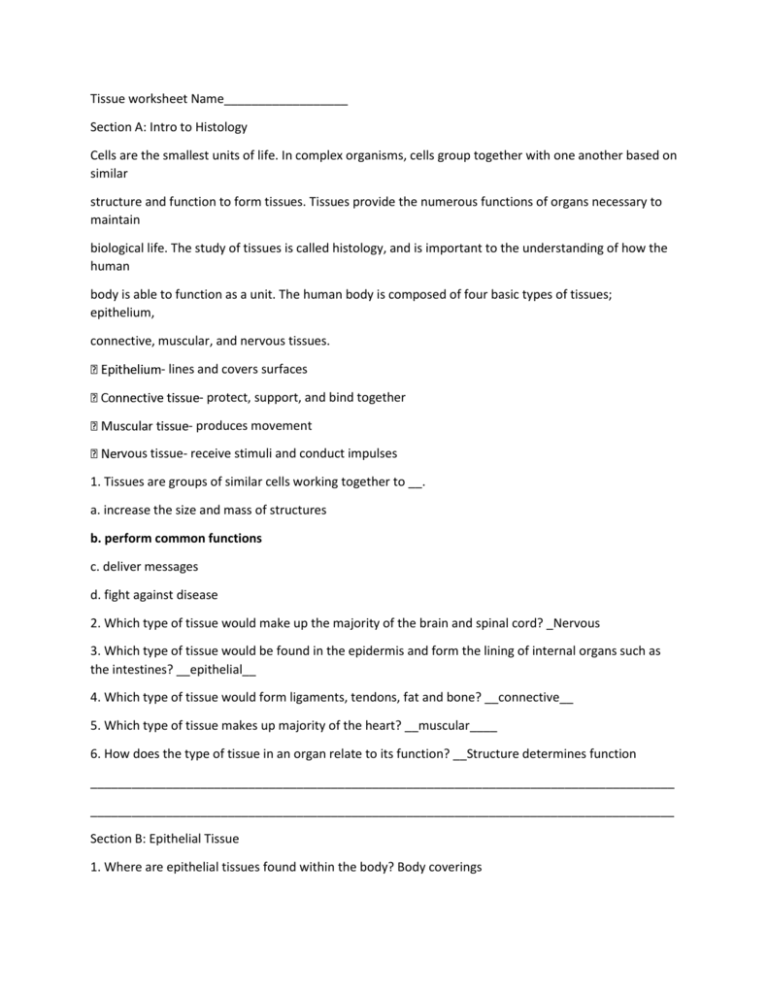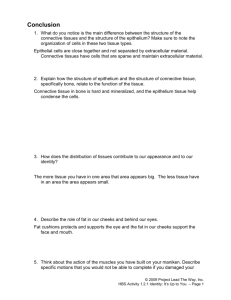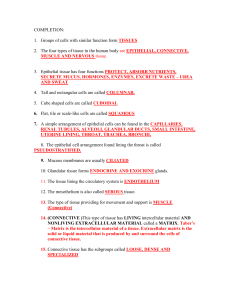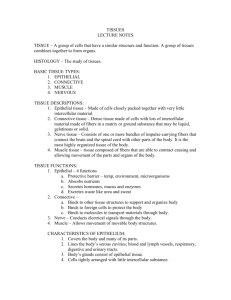Tissue worksheet Name__________________ Section A: Intro to
advertisement

Tissue worksheet Name__________________ Section A: Intro to Histology Cells are the smallest units of life. In complex organisms, cells group together with one another based on similar structure and function to form tissues. Tissues provide the numerous functions of organs necessary to maintain biological life. The study of tissues is called histology, and is important to the understanding of how the human body is able to function as a unit. The human body is composed of four basic types of tissues; epithelium, connective, muscular, and nervous tissues. - lines and covers surfaces - protect, support, and bind together - produces movement vous tissue- receive stimuli and conduct impulses 1. Tissues are groups of similar cells working together to __. a. increase the size and mass of structures b. perform common functions c. deliver messages d. fight against disease 2. Which type of tissue would make up the majority of the brain and spinal cord? _Nervous 3. Which type of tissue would be found in the epidermis and form the lining of internal organs such as the intestines? __epithelial__ 4. Which type of tissue would form ligaments, tendons, fat and bone? __connective__ 5. Which type of tissue makes up majority of the heart? __muscular____ 6. How does the type of tissue in an organ relate to its function? __Structure determines function _____________________________________________________________________________________ _____________________________________________________________________________________ Section B: Epithelial Tissue 1. Where are epithelial tissues found within the body? Body coverings ____________________________________________________________________________________ 2. What are the functions of the epithelial tissues? Sectrete, absorb, line, cover and protect 3. What do you call the upper or free surface of epithelial tissues? apical 4. What do you call the bottom layer that is attached to connective tissues? _basement__ 5. Epithelial tissue is classified based on two criteria. What are these criteria? Shape and number of layers 6. Epithelial Cells are said to be avascular. What does this mean? _____no blood supply_______________________________ 7. Why is it important for the cells in the lungs and digestive tract to be simple instead of being stratified? ____to allow for diffusion____________ ___________________________________________________________________________________ 8. Why is it important for the skin to be made up of stratified epithelial tissues instead of simple epithelial? ___to protect against abrasion and friction_______ ___________________________________________________________________________________ 9. What is unique about transitional epithelium? How is this beneficial? __stretches, allows for stretching of bladder______ ____________________________________________________________________________________ 10. What is the function of goblet cells and cilia found within or attached to the epithelium cells? In which epithelium would you find these structures? Secret mucous, found in pseudostratified and simple columnar Fill in the missing information in the chart. Epithelial Tissue Shape & layer(s) Location(s) Functions Use your chart to fill in this chart Section C: Epithelial Concept Check 1. Epithelial tissues are __avascular_ which means they have no blood flow. 2. What type of tissue always can be found underneath epithelial? ___connective__ 3. All epithelial tissues are attached to underlying tissue that holds them in place. What is this membrane called? __basement membrane_____. 4. All epithelial tissues are attached to other structures on all surfaces but one. What is the name of the “free/unattached” surface? _apical__. 5. Since the epithelial tissues have no blood flow, they are able to receive needed nutrients and expel wastes through the process known as _diffusion______. 6. Do epithelial cells reproduce rapidly or slowly? ___rapidly______ 7. Are epithelial cells tightly packed or loosely spaced? __tightly packed____ 8. You’re looking at epithelial tissue in the microscope and notice the specimen has several layers with flattened cells on the apical surface. What type of epithelial tissue are you looking at? __stratified squamous____ 9. Which type of epithelial tissue usually forms membranes where filtration or exchange of substances by diffusion occurs? (simple or stratified) _simple_ 10. In an area where an epithelium is subjected to considerable wear and tear, you would expect to find (simple or stratified)___stratified__. Identify the type of epithelial tissue that is found in the following structure(s) 11. __stratified squamous_____epidermis, esophagus, oral cavity 12. ___pseudostratified________respiratory tract (trachea) 13. ___simple squamous_____air sacs/alveoli of the lungs, capillaries 14. ___simple columnar_______digestive tract Section D: Connective Tissue 1. What characteristics do all connective tissues share in common? _cells found in a matrix, good vascularity, cells spaced apart ____________________________________________________________________________________ 2. Identify the functions of connective tissues. Connect, protect, immunity, insulation, supports, framework, stores fat 3. Identify at least 2 factors that affect the consistency of a connective tissue. In this case, consistency refers to the make-up or anatomical structure of the tissue. What factors can change the thickness/viscosity of the tissue? ____matrix and type of cell_________________________ 4. What is the extracellular matrix of connective tissue made up of? ___proteins, collagen and elastin, cells __ _____________________________________________________________________________________ 5. Why does it take tendons and ligaments longer to heal than many bone injuries? Low blood supply _____________________________________________________________________________________ _ 6. What substances make up the rigid matrix of bone? __mineral salts, collagen_____ 7. What are the three types of cartilage? Where are they located in the body? a. __hyaline- ends of bones___________________ b. __Fibrocartilage- intervertebral discs_______________________ c. _elastic- ears and larynx 8. Identify which type of connective tissue is being described. a. ___blood______ transports oxygen, carbon dioxide, nutrients, and waste through the body by traveling through vessels called arteries and veins. b. __regular dense________ is a type of dense connective tissue that connects muscles to bones and connects bone to bone. c. __reticular connective___ is a type of connective tissue that aids in the formation of red and white blood cells. This tissue is found in the spleen and the marrow. d. __bone___ is a type of connective tissue with one of the hardest extracellular matrixes that forms a protective structure used for muscle attachment. This type of connective tissue is formed by a cell known as an osteocyte. e. _areolar___ is a type of loose connective tissue that separates the cells of the body from the blood stream. It is a “go-between” for nutrients and wastes to leave and enter the blood stream on their way to and from the bodies’ cells. f. ___adipose_____ is a type of connective tissue also known as fat. Its purpose is to store excess nutrients and fats as energy. It also serves as a type of insulation for the body. g. ___cartilage___ is a semi-solid connective tissue that is used as both a protective and supportive structure within the body. This particular type of connective tissue can be found in the nose, ears, ribs, and vertebral disks. h. ___irregular dense______ is a type of dense connective tissue with irregularly arranged fibers that provides strength where tension is exerted in various directions such as in the dermis. Section E: Connective Tissue Concept Check 1. Where are connective tissue found? __All throughout body__________ 2. What are the functions of connective tissue? Same as above answer 3. Besides cells what other substances do connective tissues have? ____collagen, elastin, mast cells and macrophage____ 4. All connective tissues were derived from a common embryonic tissue. What is the name of the embryonic cells? _stem cells______ 5. How are connective tissue classified? ____type of cell and matrix_______ 6. What purpose if any do fibers like collagen and elastin provide in the extracellular matrix of connective tissues? ____collagen – strength, elastin- flexibility____________________________ _____________________________________________________________________________________ 4 Identify the type of connective tissue based on the following descriptions. 7. ___blood____contains cells surrounded by a fluid matrix that transports substances 8. ___bone____contains cells surrounded by a hard matrix that supports and protects 9. ___elastic connective____contains cells that reduce friction and allow flexibility at joints 10. __adipose________contains cells that stores energy, insulates the body and cushions organs Section F: Nervous Tissue 1. What are the two types of cells and how are they different? Neurons- transmit signal to muscle and glands Neuroglia- support neuronal function Section G: Muscle Tissue 1. What are muscle cells called? _myofibers 2. What are the functions of muscular tissue? __Movement, digestion and organ function___ ____________________________________________________________________________________ 3. Check the appropriate space(s) in the following table to indicate which muscle type exhibit the listed characteristic(s). Some characteristics may have more than one correct answer. Characteristics Skeletal Cardiac Smooth A Striated- Sk,C B No striations-Sm C Multinucleated-Sk D Uninucleated-C,Sm E Involuntary-C,Sm F Voluntary-Sk G Found in the walls of hollow organs-Sm H Attached to connective tissue-Sk I Found in the heart-C








